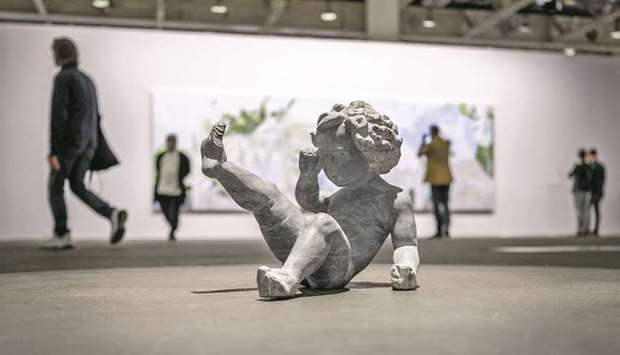Art Basel, the world’s top contemporary art fair, has returned to the Swiss city after a year’s gap due to coronavirus (Covid-19) curbs, drawing hordes of wealthy buyers and breathing life into a market devastated by the pandemic.
Despite the near-total absence of US collectors – a key client base for artists and galleries – big-money buyers were back from Tuesday to preview the works before the event opens to the public for three days from today.
After last year’s cancellation, some 272 galleries from 33 countries returned to showcase both emerging artists and major contemporary art figures such as David Hockney, Frank Bowling and Olafur Eliasson.
Exhibitors were impatiently awaiting Art Basel’s return, but at the end of August, the United States advised against travel to Switzerland, raising fears that the pandemic would spoil the comeback.
“We had an environment which was suddenly very tense,” Art Basel’s global director Marc Spiegler told AFP.
He said the fair had tried to remove traces of the pandemic inside the halls so that visitors “could focus on the artists”.
Once the doors opened, he said the atmosphere inside was “buoyant”.
“People are excited to see each other again ... to see great art in front of them, and not through a screen,” he said.
After Tuesday’s opening day, several large galleries were already lining up their first seven-figure sales – $6.5mn for an oil on canvas work by Philip Guston at the Hauser and Wirth gallery, $5-5.5mn for a Keith Haring painting at Gladstone, and $3mn for a Dan Flavin installation at David Zwirner.
“The fair is going extremely well, exceeding all expectations,” Emmanuel Perrotin, the founder of France’s Galerie Perrotin, told AFP.
Amid booming interest from European collectors, three-quarters of the works on show had already been sold by mid-afternoon, he said.
The Austrian gallery Thaddaeus Ropac had sold the three large pieces in its monumental works section, including a huge sculpture by Valie Export representing intertwined scissors.
In 2020, the art market fell by 22% to $50.1bn, according to a study by art market specialist Clare McAndrew.
Art galleries were particularly hard hit by the cancellations of major art fairs that contributed around 43% of their 2019 sales.
The boom in online sales and drastic spending cuts have allowed them to stay afloat, but many admit that this model is unsustainable in the long run.
“Online sales helped galleries to continue to work with existing clients during the pandemic,” McAndrew told AFP.
However, “art fairs are essential to meet new clients”, she explained.
The pandemic recovery has tended to favour large galleries over smaller ones with less financial leeway to cope with the shock, said Julie Hughes, head of the art market at the insurer Hiscox.
“We are not seeing any bankruptcies yet,” she said, underlining that the survival of the smallest galleries often depended on big art fairs where they can generate “30%, 50%, or even more of their annual turnover” within just a few days.
Hans Laenen, head of the art market for Europe at Axa Art, expects a resumption of purchases.
“It will be very interesting to see where the sales are at the end of the fair,” he said, adding that Art Basel will act as a barometer for trends in the art market.

Visitors look at Destruction 2019 by Japanese artist Tadashi Kawamata (above), displayed the Unlimited section of Art Basel, the world’s premier modern and contemporary art fair, in Basel.

A visitor takes a photo with her cellphone of Die Doppelgangerin, 2010, by Austrian avant-garde artist Valie Export exhibited in the Unlimited section.



